
Yasmine Dahm plays Sophie, a young girl who sets off a chain of poltergeist activity in Au Rendez-Vous de la Mort Joyeuse (1973, aka Expulsion of the Devil).
Although Luis Bunuel never made a straight up horror film in the traditional sense, many of his movies contained elements of the horrific and the fantastical such as the “mother meat” nightmare sequence in Los Olvidados (1950), the severed, crawling hand in The Exterminating Angel (1962) or the Devil in his many disguises in the 45 minute allegory, Simon of the Desert (1965). However, Juan Luis Bunuel, the director’s son, launched his feature film career with an audacious and unsettling journey into the paranormal – Au Rendez-Vous de la Mort Joyeuse (1973, aka Expulsion of the Devil) which must have made his father proud as it was brimming with the sort of anarchic disregard for the conventional and corruption of the innocent that distinguishes the master’s best films. It’s also creepy as hell.
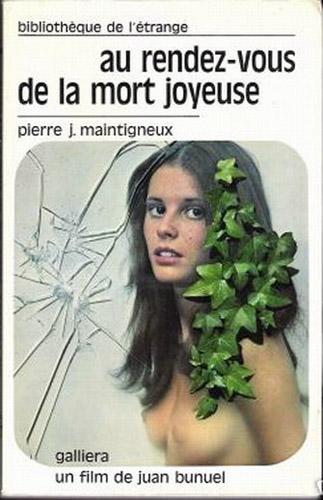 Of course, being the son of the celebrated, world famous director was not an advantage and the critics were decidedly mixed on Au Rendez-Vous de la Mort Joyeuse, which didn’t help its chances at the boxoffice and is probably why it is relatively obscure today. It was never distributed in the U.S. (though it did premiere at the Chicago International Film Festival in 1973) and received a brief, limited release in Europe. Audiences were probably divided at the time as well; the film is too restrained and non exploitive to appeal to the hard core horror fans but also a little too quirky and genre specific for the arthouse crowd. The fact that it opened almost a full year before The Exorcist is intriguing to consider now – both feature an adolescent girl protagonist – but the two movies are poles apart in their approach, the former low budget, enigmatic and eerie, the latter a major Hollywood production with state-of-the-art special effects designed for maximum shock.
Of course, being the son of the celebrated, world famous director was not an advantage and the critics were decidedly mixed on Au Rendez-Vous de la Mort Joyeuse, which didn’t help its chances at the boxoffice and is probably why it is relatively obscure today. It was never distributed in the U.S. (though it did premiere at the Chicago International Film Festival in 1973) and received a brief, limited release in Europe. Audiences were probably divided at the time as well; the film is too restrained and non exploitive to appeal to the hard core horror fans but also a little too quirky and genre specific for the arthouse crowd. The fact that it opened almost a full year before The Exorcist is intriguing to consider now – both feature an adolescent girl protagonist – but the two movies are poles apart in their approach, the former low budget, enigmatic and eerie, the latter a major Hollywood production with state-of-the-art special effects designed for maximum shock.
I first saw Au Rendez-Vous de la Mort Joyeuse on TCM sometime in 1999 and video taped it. I had hoped the network would rebroadcast it again but the license expired that same year and it has languished in obscurity ever since, a fact supported by the poor quality images being used to illustrate this post.
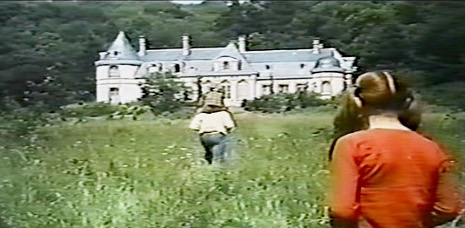
This idyllic but possibly haunted country house is the setting for Au Rendez-Vous de la Mort Joyeuse (1973), directed by Juan Luis Bunuel.
The film opens on a shot of a large, rustic country mansion at the edge of an open field and nestled against a thick forest. The point of view could be an anomymous voyeur as it slowly pans around in a 360 degree circle, taking in the sights and sounds of the bucolic countryside as the classical music score conjures up a mood of pastoral beauty crossed with ominous undercurrents.

A sense of discontent and alienation affects the lives of a family living in country house in Au Rendez-Vous de la Mort Joyeuse (1973) starring Jean-Marc Bory (left) and Yasmine Dahm as his daughter in Au Rendez-Vous de la Mort Joyeuse (1973).
The fact that two of the main characters in the movie are introduced only by their voices and hands first – for an entire scene – before we can see their faces is a clear indication that Bunuel’s approach to narrative is going to be uniquely unconventional. The voices belong to Marc (Jean-Marc Bory) and his teenage daughter Sophie (Yasmine Dahm) who is drawing a sketch of the house. Then we see them outside in the field from the same vantage point of the opening shot as they discuss their new home.
Sophie: That’s odd. No two windows are alike.
Marc: I wonder when it was built.
Sophie: At least 100 years ago.
Marc: Maybe not. They built houses like this in the 1930s.
Sophie: You were born in 1935, right?
Marc: No, in 1934. At that time, people were dancing the Fox Trot in houses like this one.
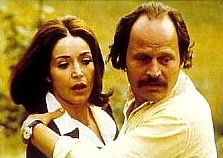
Francoise Fabian & Jean-Marc Bory play the concerned parents of Yasmine Dahm in Au Rendez-Vous de la Mort Joyeuse (1973, aka Expulsion of the Devil).
It soon becomes apparent that Marc, an illustrator, and his wife Francoise (Francoise Fabian), a writer, have left their city life behind and have relocated to the country to start a new life with their two children, including their small son, Dominique. It is also apparent that Sophie has a close relationship with her father and is jealous of the attention he gives to his son, a situation that may well explain the strange events that follow….or not.

Yasmine Dahm plays a young girl who may or may not be possessed by something evil in Au Rendez-Vous de la Mort Joyeuse (1973).
The move to the country is clearly less idyllic than imagined for Francoise who finds herself doing a lot of the renovation herself, not to mention the constant cooking and cleaning. The resentment is obvious and so is the intimation that money is a concern with neither husband or wife pulling in a steady income.
The evidence on display suggests that both Marc or Francoise failed to achieve the level of success they once desired. When Sophie asks her father why he became an illustrator if he really wanted to be an engraver by profession, he tells her, “We can’t always be what we want.” Her response is, “Weren’t you good enough?,” to which he gives a weary smile, saying “I stopped thinking about it a long time ago.” (From this point on, Sophie’s response to her father’s middle age resignation could be the film’s inner demon – just a guess).

Poltergeist activity is unleashed in Au Rendez-Vous de la Mort Joyeuse (1973), directed by Juan Luis Bunuel.
In the very first scene where Marc and Francoise appear together, a disruptive tone is introduced which continues and is amplified through the rest of the film. The couple are squabbling while Sophie looks on and then a bizarre thing happens. A bucket of paint flips upside down on the floor, spilling its murky green contents everywhere. Francoise blames Marc who denies touching the bucket while Sophie has a giggling fit. It is just the beginning of a slow onslaught of poltergeist-like activity (or is it telekinesis?) that escalates to a climax of pure panic that I won’t reveal here.

Henri (Renato Salvatori) plays a family friend who notices a change in young Sophie’s behavior in Au Rendez-Vous de la Mort Joyeuse (1973), co-starring Yasmine Dahm.
Sophie comes across as a provocative, narcissistic and manipulative little nymphet in the tradition of Lolita (Yasmine Dahm was a popular French teenage model at the time and looks a little like American actress Kay Lenz). She has an sensual smile that could be interpreted as sweetly innocent or cruel and malicious and is well aware of her own budding sexuality. We notice this first by her fascination with her own image in the mirror – a disturbing scene that quickly enters horror territory when the mirror image responds differently to the beholder. And as the film progresses, Sophie becomes increasingly conscious of her desirability among the men that visit the house; first, Henri (Renato Salvatori of Visconti’s Rocco and His Brothers and Costa-Gavras’ Z), a family friend, and later a four man television production crew, who have arrived to document the peculiar happenings in the house with the blessing of the owners.

A television crew joins other members of the household to investigate the strange goings-on Au Rendez-Vous de la Mort Joyeuse (1973). Gerald Depardieu (far right) plays a small supporting role.
Some reviewers have suggested that Au Rendez-Vous de la Mort Joyeuse is a horror allegory about female puberty and the psychic and sexual energy unleashed by it or that it could be the work of a male filmmaker expressing his fear of the opposite sex. Regardless of these interpretations, the film works best as a haunted house story but avoids most of the clichés of the genre by grounding the film in believable characters and situations.
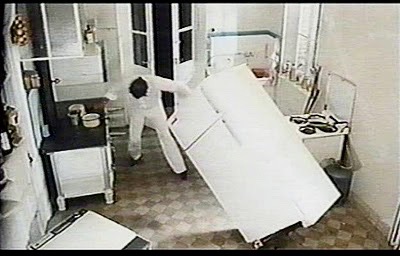
Henri (Renato Salvatori) is attacked by kitchen appliances in Au Rendez-Vous de la Mort Joyeuse (1973).
When Henri is seriously injured in an unexplainable attack on him by kitchen appliances and rushed to the hospital, the family flees the house as well like most sane people would do. And when Sophie runs away from the hospital to return to the house, it is completely plausible because it has already been established that Sophie encouraged her parents to buy the mansion in the first place and that she derives some sense of entitlement from the property. Yet her explanation for her return is quite strange.
One of the cameramen asks her, “Why did you come back?”
Sophie: I have to feed my dog.
Cameraman: Your dog? You don’t have a dog.
Sophie: Of course not.
Cameraman: Then why did you say that?
Sophie: I feel better when I give reasons.

Father D’Aval (Claude Dauphin) and two of his pupils are glimpsed through a keyhole in what turns out to be a mirage in Au Rendez-Vous de la Mort Joyeuse (1973).
When her father shows up to take his runaway daughter home, that too feels organic to the narrative, even when they are forced to spend one more night in the house because of Marc’s after hours arrival. Also, the risk of danger seems reduced due to a full house that includes the camera crew, Father D’Aval (Claude Dauphin), a teacher, and his group of schoolchildren on an overnight camping trip who used to stay in the abandoned house on previous outings. As expected, the last night in the house becomes a terrifying rollercoaster ride – at least two people appear to die amid the mayhem – and the movie fades out on an ambiguous note that comes full circle with the opening shot.

Jean-Pierre Darras plays a television producer who has a nasty supernatural encounter in Au rendez vous de la mort joyeuse (1973).
One thing I particularly love about Au Rendez-Vous de la Mort Joyeuse are the minimalistic special effects which actually seem to mirror what real poltergeist or telekinetic activity might look like if recorded by hidden cameras. Not a bunch of CGI rendered happenings or 3-D overkill but just a table flying through French doors or a refrigerator sliding on its side across the floor. Bunuel also avoids gruesome shock effects but there are still some well-timed frights and nightmarish images. When Perou (Jean-Pierre Darras), the television producer, is enticed into seducing Sophie in a dark bedroom, it ends with his realization that the little girl before him is NOT Sophie. When the camera team hear his screams and come running, they find him hysterical and covered in mud or possibly manure.

Television cameramen document unexpected occurrences at a country estate in Au Rendez-Vous de la Mort Joyeuse (1973).
Other effects are even more minimal but just as unnerving such as a scene where one of the TV crew, Beretti (a young, skinny and bearded Gerald Depardieu), is compelled to stick his hand in a pot of boiling soup. Or a scene where two crew members see, through a keyhole in the door, the schoolteacher in an inappropriate situation with two schoolgirls – and it turns out to be an illusion or hallucination in the minds of the beholders. Other weird visual touches include a piece of rotting rope that keeps turning up in unexpected places throughout the movie as if it has some diabolical purpose or life of its own and a scene in which Sophie tries to force two snails to mate (a homage to Luis Bunuel’s Diary of a Chambermaid?).

One of the many unusual images from Juan Luis Bunuel’s Au Rendez-Vous de la Mort Joyeuse (1973, aka Expulsion of the Devil).
My videotaped copy of Au Rendez-Vous de la Mort Joyeuse appears to have come from a master badly in need of remastering; the image is soft and lacks sharpness, but one is still bewitched by the evocative cinematography by Ghislain Cloquet. Cloquet photographed Arthur Penn’s Mickey One (1965), Roman Polanski’s version of Tess (1979) with Geoffrey Unsworth, Marguerite Duras’ Nathalie Granger (1972) and Robert Bresson’s Une Femme Douce (1969), among others.
I would love to see a DVD distributor like Criterion or Second Run DVD or Eureka! take this on as a future restoration/release project but the film has such a low profile that it’s off almost everyone’s radar. Still, it’s an impressive and spooky directorial debut for Juan Luis Bunuel who seems to be better known for La Femme aux bottes rouges (1974, aka The Woman With Red Boots) starring Catherine Deneuve and Fernando Rey, the supernatural tale Leonor (1975) with Liv Ullmann, Michel Piccoli, and Ornella Muti and his television work which comprises the bulk of his filmography. 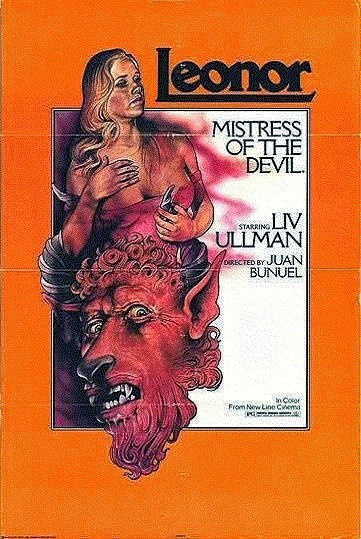 I have only seen La Femme aux bottes rouges (it is still available from Pathfinder Films) but I find it less interesting and much more imitative of his father’s work than Au Rendez-Vous de la Mort Joyeuse. I have read favorable things about Leonor (which was once distributed by New Line Cinema) but, in general, Juan Luis Bunuel is overshadowed by his father’s reputation and that will probably never change.
I have only seen La Femme aux bottes rouges (it is still available from Pathfinder Films) but I find it less interesting and much more imitative of his father’s work than Au Rendez-Vous de la Mort Joyeuse. I have read favorable things about Leonor (which was once distributed by New Line Cinema) but, in general, Juan Luis Bunuel is overshadowed by his father’s reputation and that will probably never change.
There are other filmmakers in the Bunuel family as well. Rafael Bunuel, who was born in 1940, has worked in film and television but is better known as a playwright and artist. Joyce Bunuel, Juan Luis’s ex-wife, continues to direct movies for television and launched her directorial debut with the 1978 feature Dirty Dishes (French title: La Jument Vapeur) starring Carole Laure as a housewife going slowly mad.
Au Rendez-Vous de la Mort Joyeuse, which translates as At the Meeting with Joyous Death, is a much better title than the alternate English one it was given which is completely inaccurate – Expulsion of the Devil. His Satanic Majesty is never invoked or even mentioned in Bunuel’s film and it’s pretty clear by the end of Au Rendez-Vous de la Mort Joyeuse that the only expulsion was the inhabitants of the house but not the strange forces within it. The movie might not have anything profound to say when all is said and done but as an entry in the haunted house/ghost story genre it rewards you with each repeated viewing and is guaranteed to haunt the back corridors of your mind long after seeing it.
Other links of interest:
https://www.juliericogallery.com/rafaelbunuelbio/
https://grunes.wordpress.com/2008/04/21/leonor-juan-luis-bunuel-1975/
http://mubi.com/notebook/posts/the-forgotten-the-phantom-of-puberty
https://www.youtube.com/watch?v=RZ2ju0Cf5nc (the complete film with English subtitles)




